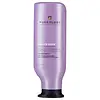What's inside
What's inside
 Key Ingredients
Key Ingredients

 Benefits
Benefits

 Concerns
Concerns

 Ingredients Side-by-side
Ingredients Side-by-side

Water
Skin ConditioningCetearyl Alcohol
EmollientBehentrimonium Chloride
PreservativeIsopropyl Myristate
EmollientCetyl Esters
EmollientIsopropyl Alcohol
SolventMentha Arvensis Leaf Oil
MaskingPhenoxyethanol
PreservativeParfum
MaskingPolyquaternium-37
Glycine Soja Oil
EmollientPropylene Glycol Dicaprylate/Dicaprate
EmollientDisodium EDTA
Glycerin
HumectantButylene Glycol
HumectantMenthol
MaskingLimonene
PerfumingTocopherol
AntioxidantPPG-1 Trideceth-6
Skin ConditioningChlorhexidine Dihydrochloride
AntimicrobialHydroxypropyltrimonium Hydrolyzed Wheat Protein
Skin ConditioningHelianthus Annuus Seed Extract
Skin ConditioningWheat Amino Acids
Skin ConditioningSodium Chloride
MaskingBenzophenone-4
UV AbsorberLinalool
PerfumingEucalyptus Globulus Leaf Extract
PerfumingAscorbic Acid
AntioxidantMelanin
Skin ProtectingPotassium Sorbate
PreservativePentylene Glycol
Skin ConditioningEthylhexylglycerin
Skin ConditioningWater, Cetearyl Alcohol, Behentrimonium Chloride, Isopropyl Myristate, Cetyl Esters, Isopropyl Alcohol, Mentha Arvensis Leaf Oil, Phenoxyethanol, Parfum, Polyquaternium-37, Glycine Soja Oil, Propylene Glycol Dicaprylate/Dicaprate, Disodium EDTA, Glycerin, Butylene Glycol, Menthol, Limonene, Tocopherol, PPG-1 Trideceth-6, Chlorhexidine Dihydrochloride, Hydroxypropyltrimonium Hydrolyzed Wheat Protein, Helianthus Annuus Seed Extract, Wheat Amino Acids, Sodium Chloride, Benzophenone-4, Linalool, Eucalyptus Globulus Leaf Extract, Ascorbic Acid, Melanin, Potassium Sorbate, Pentylene Glycol, Ethylhexylglycerin
Water
Skin ConditioningCetearyl Alcohol
EmollientIsohexadecane
EmollientIsododecane
EmollientBehentrimonium Methosulfate
Melaleuca Alternifolia Leaf Oil
AntioxidantHedychium Coronarium Root Extract
MaskingAscophyllum Nodosum Extract
Skin ConditioningAloe Barbadensis Leaf Extract
EmollientRosmarinus Officinalis Leaf Extract
AntimicrobialAnthemis Nobilis Flower Extract
MaskingSimmondsia Chinensis Leaf Extract
HumectantPPG-5-Ceteth-20
EmulsifyingCitric Acid
BufferingTetrasodium EDTA
Magnesium Nitrate
Bisamino PEG/PPG-41/3 Aminoethyl Pg-Propyl Dimethicone
PEG-12 Dimethicone
Skin ConditioningSodium Glycolate
BufferingMethylisothiazolinone
PreservativeMethylchloroisothiazolinone
PreservativeMagnesium Chloride
Sodium Hydroxide
BufferingParfum
MaskingLimonene
PerfumingCI 42090
Cosmetic ColorantCI 19140
Cosmetic ColorantWater, Cetearyl Alcohol, Isohexadecane, Isododecane, Behentrimonium Methosulfate, Melaleuca Alternifolia Leaf Oil, Hedychium Coronarium Root Extract, Ascophyllum Nodosum Extract, Aloe Barbadensis Leaf Extract, Rosmarinus Officinalis Leaf Extract, Anthemis Nobilis Flower Extract, Simmondsia Chinensis Leaf Extract, PPG-5-Ceteth-20, Citric Acid, Tetrasodium EDTA, Magnesium Nitrate, Bisamino PEG/PPG-41/3 Aminoethyl Pg-Propyl Dimethicone, PEG-12 Dimethicone, Sodium Glycolate, Methylisothiazolinone, Methylchloroisothiazolinone, Magnesium Chloride, Sodium Hydroxide, Parfum, Limonene, CI 42090, CI 19140
Ingredients Explained
These ingredients are found in both products.
Ingredients higher up in an ingredient list are typically present in a larger amount.
Cetearyl alcohol is a mixture of two fatty alcohols: cetyl alcohol and stearyl alcohol. It is mainly used as an emulsifier. Emulsifiers help prevent the separation of oils and products. Due to its composition, it can also be used to thicken a product or help create foam.
Cetearyl alcohol is an emollient. Emollients help soothe and hydrate the skin by trapping moisture.
Studies show Cetearyl alcohol is non-toxic and non-irritating. The FDA allows products labeled "alcohol-free" to have fatty alcohols.
This ingredient is usually derived from plant oils such as palm, vegetable, or coconut oils. There is debate on whether this ingredient will cause acne.
Due to the fatty acid base, this ingredient may not be Malassezia folliculitis safe.
Learn more about Cetearyl AlcoholLimonene is a fragrance that adds scent and taste to a formulation.
It's found in the peel oil of citrus fruits and other plants such as lavender and eucalyptus. The scent of limonene is generally described as "sweet citrus".
Limonene acts as an antioxidant, meaning it helps neutralize free radicals.
When exposed to air, oxidized limonene may sensitize the skin. Because of this, limonene is often avoided by people with sensitive skin.
The term 'fragrance' is not regulated in many countries. In many cases, it is up to the brand to define this term. For instance, many brands choose to label themselves as "fragrance-free" because they are not using synthetic fragrances. However, their products may still contain ingredients such as essential oils that are considered a fragrance.
Learn more about LimoneneParfum is a catch-all term for an ingredient or more that is used to give a scent to products.
Also called "fragrance", this ingredient can be a blend of hundreds of chemicals or plant oils. This means every product with "fragrance" or "parfum" in the ingredients list is a different mixture.
For instance, Habanolide is a proprietary trade name for a specific aroma chemical. When used as a fragrance ingredient in cosmetics, most aroma chemicals fall under the broad labeling category of “FRAGRANCE” or “PARFUM” according to EU and US regulations.
The term 'parfum' or 'fragrance' is not regulated in many countries. In many cases, it is up to the brand to define this term.
For instance, many brands choose to label themselves as "fragrance-free" because they are not using synthetic fragrances. However, their products may still contain ingredients such as essential oils that are considered a fragrance by INCI standards.
One example is Calendula flower extract. Calendula is an essential oil that still imparts a scent or 'fragrance'.
Depending on the blend, the ingredients in the mixture can cause allergies and sensitivities on the skin. Some ingredients that are known EU allergens include linalool and citronellol.
Parfum can also be used to mask or cover an unpleasant scent.
The bottom line is: not all fragrances/parfum/ingredients are created equally. If you are worried about fragrances, we recommend taking a closer look at an ingredient. And of course, we always recommend speaking with a professional.
Learn more about ParfumWater. It's the most common cosmetic ingredient of all. You'll usually see it at the top of ingredient lists, meaning that it makes up the largest part of the product.
So why is it so popular? Water most often acts as a solvent - this means that it helps dissolve other ingredients into the formulation.
You'll also recognize water as that liquid we all need to stay alive. If you see this, drink a glass of water. Stay hydrated!
Learn more about Water